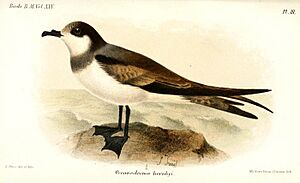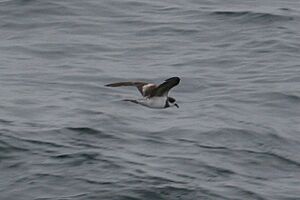Ringed storm petrel facts for kids
Quick facts for kids Ringed storm petrel |
|
|---|---|
 |
|
| Conservation status | |
| Scientific classification | |
| Genus: |
Hydrobates
|
| Species: |
hornbyi
|
 |
|
| Synonyms | |
|
Oceanodroma hornbyi |
|
The ringed storm petrel (Hydrobates hornbyi), also called Hornby's storm petrel, is a small seabird that lives in the Humboldt Current off the coasts of South America. This bird is easy to spot because of its unique look: it has a dark cap on its head, a white face, white belly, a forked tail, and a black band across its chest. You can often find it in the seas near Peru, Chile, and Ecuador. The bird is named after Admiral Sir Phipps Hornby.
What's in a Name?
Scientists give every animal a special name. The ringed storm petrel was first officially named in 1854 by an English zoologist named George Gray. He called it Thalassidroma hornbyi back then.
He chose the name hornbyi to honor Admiral Sir Phipps Hornby. Admiral Hornby was the person who found the first specimen of this bird. Today, scientists place this bird in the genus Hydrobates.
Reproduction and Life Cycle
Not much was known about how the ringed storm petrel reproduces for a long time. But in April 2017, Chilean bird experts found the first-ever breeding colony of these seabirds. This was a very exciting discovery!
They found the nests in the Atacama Desert in northern Chile. What's surprising is that these nests were over 70 kilometers (about 43 miles) away from the sea! This is not where you would expect to find a seabird.
Scientists believe these birds breed between March and July. This is when young birds, called fledglings, are often seen near cities like Lima, Peru, and Antofagasta, Chile. Sometimes, young birds get confused by city lights and end up stranded on streets.
There have also been reports of mummified young and adult birds found in cracks in the Atacama Desert. Some birds have been seen as far as 150 kilometers (about 93 miles) from the sea. The first confirmed nest was found by volunteers in the Atacama Desert in 2017.
How Many Birds Are There?
It's hard to know exactly how many ringed storm petrels there are in the world. When they are at sea, experts estimate their population to be in the thousands or even tens of thousands.
Sometimes, a ringed storm petrel might fly far off its usual path. One was recently seen off the coast of California by a team from the NOAA. This shows how far these birds can travel!




